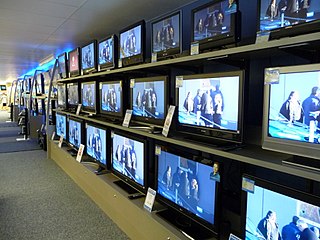
NTSC, named after the National Television System Committee, is the analog television color system that was used in North America from 1954 and until digital conversion, was used in most of the Americas ; Myanmar; South Korea; Taiwan; Philippines; Japan; and some Pacific island nations and territories.

Color television is a television transmission technology that includes information on the color of the picture, so the video image can be displayed in color on the television set. It is an improvement on the earliest television technology, monochrome or black and white television, in which the image is displayed in shades of gray (grayscale). Television broadcasting stations and networks in most parts of the world upgraded from black and white to color transmission in the 1970s and 1980s. The invention of color television standards is an important part of the history of television, and it is described in the technology of television article.
For the American TV schedule, see: 1962–63 United States network television schedule.

Black-and-white images combine black and white in a continuous spectrum, producing a range of shades of gray.

The All-Channel Receiver Act of 1962 (ACRA), commonly known as the All-Channels Act, was passed by the United States Congress in 1961, to allow the Federal Communications Commission to require that all television set manufacturers must include UHF tuners, so that new UHF-band TV stations could be received by the public. This was a problem at the time since the Big Three television networks were well-established on VHF, while many local-only stations on UHF were struggling for survival.

A television set or television receiver, more commonly called a television, TV, TV set, or telly, is a device that combines a tuner, display, and loudspeakers for the purpose of viewing television, viewing any computer's screen, or viewing home video game consoles. Introduced in the late 1920s in mechanical form, television sets became a popular consumer product after World War II in electronic form, using cathode ray tubes. The addition of color to broadcast television after 1953 further increased the popularity of television sets in the 1960s, and an outdoor antenna became a common feature of suburban homes. The ubiquitous television set became the display device for the first recorded media in the 1970s, such as Betamax, VHS and later DVD. It was also the display device for the first generation of home computers and video game consoles in the 1980s. In the 2010s flat panel television incorporating liquid-crystal displays, especially LED-backlit LCDs, largely replaced cathode ray tubes and other displays. Modern flat panel TVs are typically capable of high-definition display and can also play content from a USB device.

Richard Allen Boone was an American actor who starred in over 50 films and was notable for his roles in Westerns, including his starring role in the television series Have Gun – Will Travel.
Zenith Electronics, LLC is a research and development company that develops ATSC and digital rights management technologies. It is owned by the South Korean company LG Electronics. Zenith was previously an American brand of consumer electronics, a manufacturer of radio and television receivers and other consumer electronics, and was headquartered in Glenview, Illinois. After a series of layoffs, the consolidated headquarters moved to Lincolnshire, Illinois. For many years, their famous slogan was "The quality goes in before the name goes on." LG Electronics acquired a controlling share of Zenith in 1995; Zenith became a wholly owned subsidiary in 1999. Zenith was the inventor of subscription television and the modern remote control, and the first to develop High-definition television (HDTV) in North America.
The Marriage is an American sitcom that aired on NBC from July to August 1954. The series is noted as the first prime time network color television series. Broadcast live by NBC for seven episodes in the summer of 1954, the series stars real-life couple Hume Cronyn and Jessica Tandy as a New York lawyer and his wife with two children, played by Susan Strasberg and Malcolm Brodrick.
The World Is Yours was an early television series, making its debut on June 26, 1951, on several stations of the CBS television network in the eastern United States. This half-hour daytime program was hosted from New York by naturalist and author Ivan T. Sanderson, and was broadcast Monday through Friday. Mr. Sanderson's assistant was "Patty Painter" a model and CBS employee who had posed for on-camera tests of CBS's color television system since 1946. The producer-director for the show was Frances Buss. The first episode of the series was sponsored by General Mills and included commercials for Betty Crocker cake mixes.
The invention of the television was the work of many individuals in the late 19th century and early 20th century. Individuals and corporations competed in various parts of the world to deliver a device that superseded previous technology. Many were compelled to capitalize on the invention and make profit, while some wanted to change the world through visual and audio communication technology.
Hoffman Television was a manufacturer of television sets in the 1950s and 1960s.
Ford Theatre, spelled Ford Theater for the radio version and known as Ford Television Theatre for the TV version, is a radio and television anthology series broadcast in the United States in the 1940s and 1950s. At various times the television series appeared on all three major television networks, while the radio version was broadcast on two separate networks and on two separate coasts. Ford Theatre was named for its sponsor, the Ford Motor Company, which had an earlier success with its concert music series, The Ford Sunday Evening Hour (1934–42).
WJZB-TV, UHF analog channel 14, was a television station located in Worcester, Massachusetts, United States. The station existed from 1953 to 1969.
A field-sequential color system (FSC) is a color television system in which the primary color information is transmitted in successive images and which relies on the human vision system to fuse the successive images into a color picture. One field-sequential system was developed by Dr. Peter Goldmark for CBS, which was its sole user in commercial broadcasting. It was first demonstrated to the press on September 4, 1940, and first shown to the general public on January 12, 1950. The Federal Communications Commission adopted it on October 11, 1950 as the standard for color television in the United States, but it was later withdrawn.
Frances Buss Buch was the first female television director in the United States.
Premiere is the first commercially sponsored television program to be broadcast in color. The program was a variety show which aired as a special presentation on June 25, 1951, on a five-city network hook-up of Columbia Broadcasting System (CBS) television stations. Its airing was an initial step in CBS's brief and unsuccessful campaign to gain public acceptance of its field-sequential method of color broadcasting, which had recently been approved by the Federal Communications Commission (FCC) as the first color television broadcasting standard for the United States.








